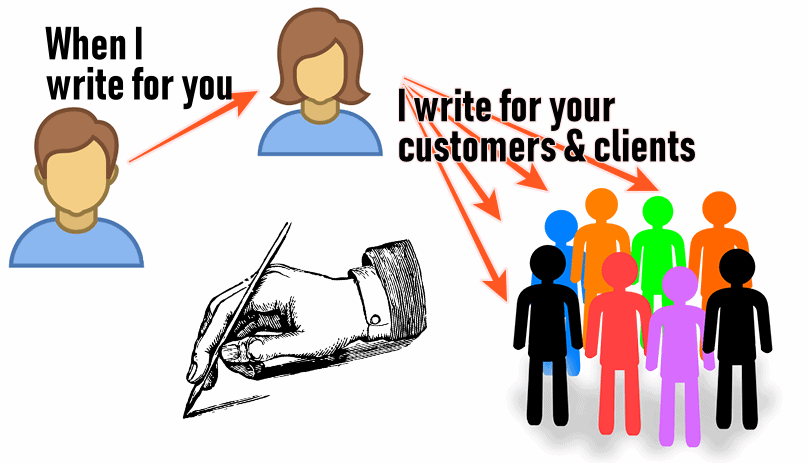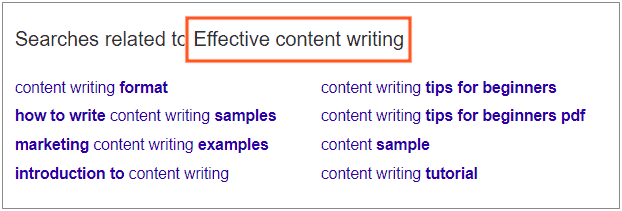My every content writing project begins with an understanding of the pain points of, not my own clients, but the customers and clients of my clients.

When I’m writing content for your business, whether it is your website content, your blog, your newsletter, your case study or your e-book, although you are paying me and I’m writing for you, the audience is YOUR customers and clients.
Why effective content writing means understanding customer’s pain points?

By the end of the day, everyone is looking for a solution to his or her problem.
If you are an app developer, your client is looking for an app developer she can totally depend on in terms of writing perfect code and finishing the project on time, within the stipulated budget.
She may also be having problems looking for an app developer who can work in the technology stack she needs.
As an app developer, you need to tell your prospective clients that you have just the right app development solution they are looking for.
Similarly, what are the pain points of my clients when they approach me for my content writing services?
- They need well-written, high-quality content on their website or blog.
- They want to generate more business and hence, they need content writing that converts.
- The need to improve their search engine rankings for their target search terms so, they need content that is search engine friendly and optimized.
- They need someone who can write content consistently and with a consistent level of quality.
These are the main pain points.
These are needs. Why am I calling them “pain points”?
It’s just another way of saying what my clients need and what they stand to lose if they don’t get what they need.
A pain point is a specific problem your prospective customer or client is facing.
For example, if you don’t get a professional content writer who can improve your conversion rate as well as SEO, you stand to lose business.
That’s a terrible thought. Hence, a pain point is, not being able to find the right content writer.
In terms of my content writing services, the pain points can be further explained as:
- Not getting a good writer within their budget.
- The current writing is lousy, ineffective, and even unprofessional.
- The current content is not selling and increasing business.
- They need to publish more content but are not able to do so.
- They or their current content writer cannot strike a perfect balance between quality content writing and search engine optimization.
- The email campaigns generate no response.
- The blog posts generate no traffic.
- There are no queries from their website.
- People don’t share the content on social media.
As a content writer eager to get business, my job is to address all this pain points and explain to my clients that they are going to get solutions to their problems when they hire me as a writer.
The same applies to your content.
For effective content writing, you need to understand what you provide, how you help people solve their problems, and what solutions you deliver.
For your content writing to be effective, it needs to be multifaceted.
When people are on your website, they should be able to easily understand what you’re trying to communicate.
Your writing should be able to convince them.
To be able to generate traffic from search engines, you must optimize your content according to the queries your target audience uses.
If you provide hair treatment services people won’t just look for “hair treatment services”, although, in this case, they may look for exactly this search term.
But anyway, they may also look for something like “how to stop losing hair”, or “treatment for dandruff” or “help with alopecia” and so on.
Hence, if you are writing content for a hair treatment services website, you need to write content addressing all the pain points of prospective clients.
Is knowing pain points only relevant to content writing?
Not at all. Yes, knowing the pain points of your customers and clients certainly helps you make your content writing effective, but every product or service in the market succeeds when it is addresses the right pain points.
Take for example word processing.
The developer of a word processor needs to know what difficulties the users face when working on documents.
If the developer goes on his own tangent and instead of focusing on the text he begins to obsess with graphics and video, he is not providing what his users are looking for – quality proofreading, formatting, real-time collaboration and inserting other design elements into the document.
Pain points play an important role in the success of every product or service.
Even your house takes care of the pain points of your need to live somewhere comfortably and feel protected.
How to know the pain points of your customers and clients for better content writing?
This is not as easy as it sounds. But you can do the following:
Talk to people
Talk to people and note down how they talk about the problems and hurdles they are facing in their day-to-day lives, especially pertaining to a particular facet of their lives that may be impacted by your product or service.
You need to make this interaction an integral part of your content writing and content marketing strategy. Constantly talk to people and understand how they converse about your industry in general and your product or service in particular, and then use that language to write your content.
Seek advice from Google
Google isn’t just good for searching for information. Once you search for a string, it also presents you with numerous suggestions to improve your search.

For example, if you search for “effective content writing”, at the bottom Google also gives you the following suggestions you may like to try:
- content writing format
- how to write content writing samples
- marketing content writing examples
- introduction to content writing
- content writing tips for beginners
- content writing tips for beginners pdf
- content sample
- content writing tutorial
These suggestions may seem totally disconnected for this particular phrase, for your phrase, they may give you an insight into what other searches people are using to find information on your product or service.
Keep a tab on social media
People use social media to vent out.
Even when they are not venting out, they are constantly posting interesting and thought-provoking questions and these questions can lead you to better understanding the pain points your customers and clients have.
You can use Quora, Facebook, Twitter and LinkedIn to track conversations about your product or service (or whatever social networking thing is going on right now).
Concluding remarks on effective content writing and understanding pain points
Content writing is all about improving conversion rate and drawing targeted traffic from various sources including search engines.
People convert (become your customers and clients, or subscribers) when they are convinced that you are offering the right solution to their problem/pain point.
This means addressing the problem at hand and presenting a solution through your writing.
Even on Google, if the searcher doesn’t feel that you are offering the right solution, he or she won’t click the link and visit your website.
Similarly, unless people are satisfied with your solution, they won’t share your links on their social media profiles.
Understanding pain points of your customers and clients also helps you come up with highly useful content on an ongoing basis. This is because, your customers and clients are always going to have one or another problem and you constantly need to provide solutions.
